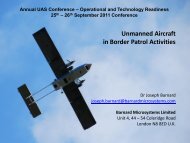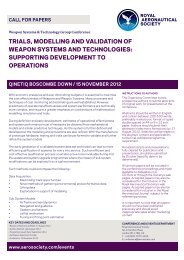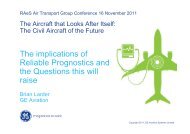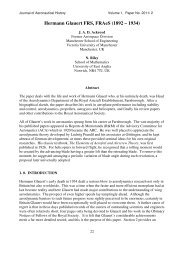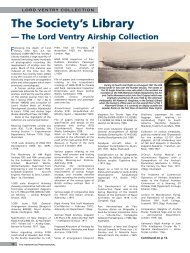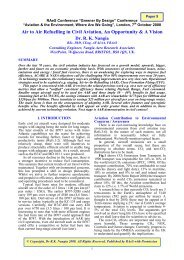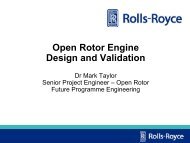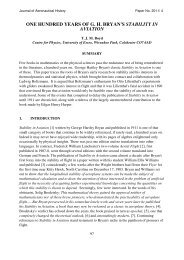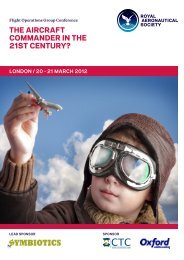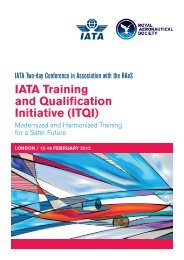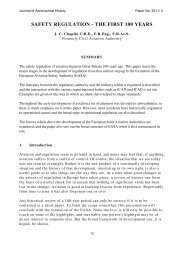DTS Paper.qxp - Royal Aeronautical Society
DTS Paper.qxp - Royal Aeronautical Society
DTS Paper.qxp - Royal Aeronautical Society
You also want an ePaper? Increase the reach of your titles
YUMPU automatically turns print PDFs into web optimized ePapers that Google loves.
The growth area for employment will be in servicing and upgrading.<br />
prefer to focus on projects and programme areas that have the<br />
best chance of meeting immediate requirements. This will deter<br />
commitment to higher risk, longer-term areas. The so-called<br />
Grand Challenge projects inspired by the US DARPA experience<br />
may mitigate this to some extent. However, these may not be<br />
launched in great numbers and financial allocations will be<br />
modest. The aerospace sector cannot expect to be singled out for<br />
inclusion in any specific Grand Challenge.<br />
Some operational issues<br />
43. Finally, the future for the operational side of the profession<br />
contains a mixture of continuing trends toward smaller, smarter<br />
forces. While flying fast jets and support aircraft will remain core<br />
applications of piloting skills in a conventionally structure air<br />
force, systems managers will be even more vital to the air force<br />
and associated services. Moreover, the deployment of UAS,<br />
especially the more sophisticated, autonomous aircraft, may<br />
demand a different type of remote piloting skills. This has been<br />
termed air awareness rather airmanship.<br />
8.0 FINAL OBSERVATIONS<br />
DIS/<strong>DTS</strong> a good start, but challenges remain for the MoD<br />
and Industry<br />
44. In terms of overall quality and depth of analysis the DIS and<br />
the <strong>DTS</strong> match comparable studies in the US and are unrivalled in<br />
Europe. There is also a sense of urgency attached to the<br />
implementation plans and specific task-forces attached to both<br />
documents. Wisely, the MoD Chief Scientist has described the<br />
MoD’s approach as ‘only a first pass’ at defining a road map for<br />
industry and academia to inform their planning. The intention is<br />
to start a dialogue with the UK defence community. The <strong>DTS</strong> must<br />
also be adaptable to scientific and technological change.<br />
45. Theses caveats notwithstanding, the DIS and <strong>DTS</strong>, if fully<br />
implemented, are together intended to provide a stable<br />
framework for company planning as well as reinforcing the value<br />
of partnership between customer and suppliers. There is much<br />
still to be done, however, and there are several areas still to be<br />
resolved in the short term if a number of key capabilities are to<br />
be retained in the UK. Moreover there remain unanswered<br />
questions about the level of investment the aerospace sector can<br />
expect over the next few years — and in the case of the <strong>DTS</strong>, a<br />
classified programme (including nuclear) that might drain<br />
resources from conventional equipment R&D.<br />
Long-term stability<br />
46. To achieve real long-term stability, the strategy will to<br />
negotiate changes in government priorities and of administration.<br />
There are, of course, underlying trends in defence technology and<br />
its environment which will impose some constraints on future<br />
ministers and officials. The pressure of events will also present new<br />
challenges. In its favour, the <strong>DTS</strong> emphasises the importance of<br />
flexibility and resilience in identifying research priorities but<br />
industry cannot be entirely confident that its long-term<br />
investment in research will be sustainable in a period of political<br />
flux. Companies will have no comeback if they are faced with<br />
nugatory investment and are unlikely to receive assistance in the<br />
event of a major crisis. There is certainly a continued requirement<br />
to improve the profit margins on defence work to encourage a<br />
greater willingness to bear such risks.<br />
47. One of the most demanding aspects of the MoD’s overall<br />
approach to the UK DTIB will be maintaining capability in the<br />
absence of specific programmes. Whether through a<br />
comprehensive programme of technology demonstration or some<br />
other ‘virtual’ approach to the problem this will require adequate<br />
levels of funding sustained over long periods. It will also be<br />
essential to include supplier companies to a considerable depth or<br />
face the danger of hollowing out the UK defence industrial base.<br />
Working in the new defence research institutional<br />
framework<br />
48. The UK defence industry also faces a future operating within<br />
a new research institutional context. The privatisation of QinetiQ<br />
is a done deal and the UK is still alone of the major defence<br />
industrial powers in having a commercially motivated national<br />
research centre. The relationship with DSTL will also pose new<br />
challenges for industry. The MoD promises a new era of<br />
competitive research tendering which may offer industry new<br />
opportunities but the current strengths of the UK DTIB were in<br />
part based on a co-operative regime with the government<br />
research agencies and laboratories. In the future, the new<br />
relationships and competitive dynamics may be beneficial —<br />
there may certainly be a better and a more direct flow between<br />
innovation and commercial exploitation (in both defence and civil<br />
markets). But this remains unknown territory.<br />
Rapid and fundamental changes required of customer and<br />
supplier alike<br />
49. The DIS pointed to a new business model demanding radical<br />
changes on the part of the supplier. This should also entail equally<br />
radical changes on the part of the customer. In the first instance<br />
this should entail adopting clearer and more consistent<br />
approaches to full life support contracting as well implementing<br />
the recommendations of the critical evaluation of procurement<br />
practices that the MoD and the National Audit Office have been<br />
jointly conducting. These must be encouraged and their<br />
prescriptions implemented as a matter of urgency.<br />
FEBRUARY 2007 11



